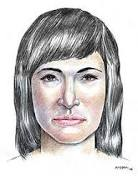This article takes us back to November 29, 1970, when a family looking for a peaceful Sunday hike in the Isdalen Valley near Bergen, Norway discovered the body of a woman between a few large rocks. This one discovery would later grow out to be one of the most mysterious cold cases of all time: The case of the Isdal woman…
A lot can be said about the first look at the woman; however, what police lawyer Carl Halvor Aas first noticed was the extremely strong smell of burnt flesh. Common in burnt bodies, the arms of the woman were in a boxer position in the air.Strangely enough, the front part of the woman (including her face) was burned beyond recognition, while the back remained untouched. No police officers were able to tell how long she had been in this state. The woman was between 25 to 30 years old, and was around 5 feet and 5 inches tall.
Police were able to discover a few items from the scene, including a broken umbrella, jewelry, a watch, glass bottles, remnants of nylon stockings and a pair of rubber boots. It’s worth mentioning that the jewelry and watch were not found on the woman. But were oddly and very neatly placed beside her on one of the rocks. All the labels on her items were removed, including the glass bottles, so as to leave no clues that would lead to her identity.
This is when police were started to look for a witness to (hopefully) be able to identify the woman. When the search failed, officers concluded that an autopsy would at the very least give them some clues as to how the woman died.
The autopsy later discovered 50 to 70 pills of fenema (a sleeping pill) in her stomach. Her blood stream did not fully absorb them before her death. They also discovered large smoke particles, meaning that she was still alive while she burned. There was a high level of carbon monoxide in her system and a bruise on the right side of her neck.
Moving on to the crime scene itself, petrol was found near the Isdal woman’s body and it was evident it was utilized in the burning. The place of her death was a known place for suicide in the Middle Ages and was where a lot of unfortunate hikers fell to their death in the 1960s. This earned the site the name of Death Valley by most locals. The site was NOT a hiking path: it was difficult to climb and was very remote.
Three days after the discovery, two suitcases were found at a train station in Bergen. Inside them were wigs, clothes, a hair brush, a comb, makeup, money from Norway and Germany, coins from Switzerland, Belgium and the UK and a tube of eczema cream that had the prescription label removed. The makeup that was in the suitcase had the label removed too, and the efforts to identify the brands had failed. One of the biggest clues was a pair of non-prescription glasses with a fingerprint on the lens. This helped link the suitcases to the crime scene as the fingerprint was a match to the Isdal Woman.

While all these items may be strange, the notepad discovered had to be the most bizarre item in the suitcases. Inside was a code written in blue ink, one that could not be cracked at the time. Another bizarre item was a plastic bag that was linked to a shoe store 130 miles away from the crime scene. The owner’s son, Rolf Rortvedt, described the woman he sold blue celebrity boots to three weeks prior. These boots matched the ones in the crime scene.

Rortvedt described the woman extremely well: she was well-dressed, of medium height and had a round face with dark brown eyes and hair. She also had a strange odour to her that Rolf realized years later was garlic. His description led authorities to a hotel called St Svithun hotel, where the woman stayed under the name of Fenella Lorch.
This brings us back to the code in the notepad, where it turns out that Fenella Lorch was not the woman’s real name. Instead, the woman had at least eight names that she used at hotels around Norway, which leads us to know that the woman had multiple passports. Police managed to match up the names using handwriting analysis on the hotel check in forms and cross referencing it with the code found in the suitcase. The letters and numbers in the code perfectly corresponded to the Isdal Woman’s stay in all the cities.
For the codes on most of the page, the numbers represent the exact days of the woman’s stay, while the first letter would represent the month, creating a date. The second letter is the first letter of the city.
Here’s a diagram that simplifies the explanation:

This case is going to be turning 50 years old this year and yet, the world’s best detectives are still unable to solve who this mysterious woman is. Perhaps maybe one day this mystery will be solved, but definitely not in the near future…


